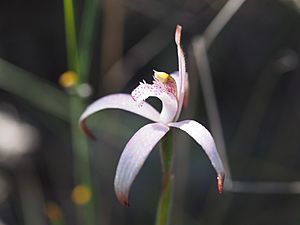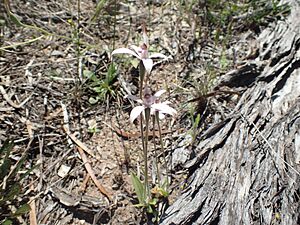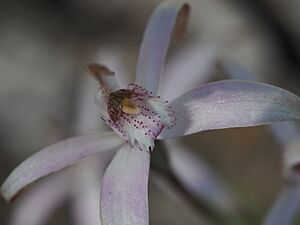Pink candy orchid facts for kids
Quick facts for kids Pink candy orchid |
|
|---|---|
 |
|
| Caladenia hirta subsp. rosea growing near Hyden | |
| Scientific classification |
|
| Kingdom: | Plantae |
| Clade: | Tracheophytes |
| Clade: | Angiosperms |
| Clade: | Monocots |
| Order: | Asparagales |
| Family: | Orchidaceae |
| Subfamily: | Orchidoideae |
| Tribe: | Diurideae |
| Genus: | Caladenia |
| Species: |
C. hirta
|
| Subspecies: |
C. h. subsp. rosea
|
| Trinomial name | |
| Caladenia hirta subsp. rosea Hopper & A.P.Br.
|
|
The Caladenia hirta subsp. rosea, also known as the pink candy orchid, is a beautiful plant. It belongs to the orchid family and grows only in the south-west part of Western Australia. This means it is endemic to that area. It's a common orchid that you can find in many places. It has a single leaf and usually grows in groups. Its flowers are a lovely pale pink to deep pink color.
Contents
What the Pink Candy Orchid Looks Like
The pink candy orchid is a plant that grows on land, not in water. It's a perennial plant, which means it lives for many years. It also has an underground tuber, which is like a small storage root. This orchid usually grows in clumps, forming little groups.
It has one hairy leaf that lies flat on the ground. This leaf is about 4 to 10 centimeters (1.5 to 4 inches) long and 0.5 to 1 centimeter (0.2 to 0.4 inches) wide.
The orchid can have up to three flowers on a single stem. The flowers are about 2 to 3 centimeters (0.8 to 1.2 inches) long and wide. The stem itself can be 10 to 25 centimeters (4 to 10 inches) tall. The flowers are pale pink to a deep pink color.
Flower Parts Explained
Let's look closely at the flower:
- The top part of the flower, called the dorsal sepal, stands straight up.
- The lateral sepals are wider than the petals. These sepals and the petals first spread out a bit, then curve downwards.
- The labellum is a special lip-like part of the orchid flower. It is white to pink and its tip rolls downwards.
- Along the sides of the labellum, there are many small teeth.
- In the center of the labellum, you'll see four or more rows of pink calli. These are small, raised bumps.
This orchid blooms from late June to September. It's different from another type of Caladenia hirta because it grows in clumps, has smaller flowers, blooms earlier, and is found more inland.
How it Got its Name
The scientific name for this orchid is Caladenia hirta subsp. rosea. The main name, Caladenia hirta, was first described in 1840 by a scientist named John Lindley. He wrote about it in a book called A Sketch of the Vegetation of the Swan River Colony.
Later, in 2001, two other scientists, Stephen Hopper and Andrew Brown, looked at the plant more closely. They decided there were two slightly different types, or subspecies. They named one of these rosea. They published their findings in a science journal called Nuytsia.
The word rosea comes from Latin and means "of roses." This name was chosen because of the lovely pink color of the orchid's flowers, which reminds people of roses.
Where the Pink Candy Orchid Lives
The pink candy orchid is found all over the south-west part of Western Australia. You can see it from Kalbarri in the north, all the way to Israelite Bay in the east.
It likes to grow in areas with trees (woodland) and in places with lots of shrubs (shrubland). You can also find it growing in thin soil on top of large granite rocks.
Looking After the Pink Candy Orchid
The Western Australian Government's Department of Parks and Wildlife has looked at the pink candy orchid. They have officially said that Caladenia hirta subsp. rosea is "not threatened." This means it is not currently in danger of disappearing, which is great news!



